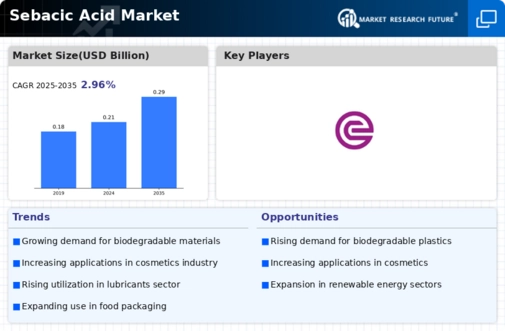Sebacic Acid Size
Sebacic Acid Market Growth Projections and Opportunities
Sebacic Acid Market elements and growth are shaped by several factors. Total sebacic acid market value was $0.196 billion in 2022. Sebacic acid sales are predicted to rise 3.40% from 2023 to 2032, reaching USD 0.265 Billion. Sebacic Acid is widely used in polymer assembly, especially biodegradable compounds, driving the market. Nylon, polyester, and other polymers require castor oil dicarboxylic acid sebacic acid. The market is driven by the demand for economical, eco-friendly materials, which sebacic acid plays in green and biodegradable polymer development.
Sebacic Acid Market factors depend on global economic conditions. Financial security affects current activities, manufacturing cycles, and consumer purchasing, impacting sebacic acid demand. Sebacic acid demand rises as materials, polymers, and car components are produced during economic expansion, affecting the market. Financial slumps may reduce current result and buyer expenditure, affecting the Sebacic Acid Market.
Plastics and polymers affect the Sebacic Acid Market. Sebacic acid is essential to biodegradable polymers, which are used in packaging, manufacturing, and consumer goods. Plastics demand, driven by the global trend toward eco-friendly materials, directly affects the Sebacic Acid Market.
Mechanical advances and polymer amalgamation methods shape the Sebacic Acid Market. Continuous innovation improves sebacic acid production and polymer joining efficiency and cost. Mechanical advances make sebacic acid-based goods more serious, allowing them to adapt to market trends and be used in new industries like beauty care and therapeutic devices.
Environmental standards and supportability considerations shape the Sebacic Acid Market. Due to its role in biodegradable and viable polymers, sebacic acid is in high demand as companies strive to be environmentally friendly. Compliance with strict natural norms and appropriate methods boost the market. Market responds to corporate duty to reduce natural effect of polymer synthesis and improve maintainability.
Buyer preferences and market trends also shape the Sebacic Acid Market. Customers and companies are becoming more mindful of natural effects and looking for alternatives to traditional plastics. Sebacic acid-based polymers are becoming more popular. The market adapts to end-client businesses that use biodegradable materials to achieve maintainability goals and customer expectations.
Serious estimates and optional material availability affect the Sebacic Acid Market. Ventures employing sebacic acid must consider its cost compared to other feedstocks or replacements such petrochemical-inferred polymers. Access to alternatives or alternative biopolymers might also impact market aspects. In response to supply-demand fluctuations, the market adjusts sebacic acid-based product pricing, production efficiency, and cost."






Leave a Comment